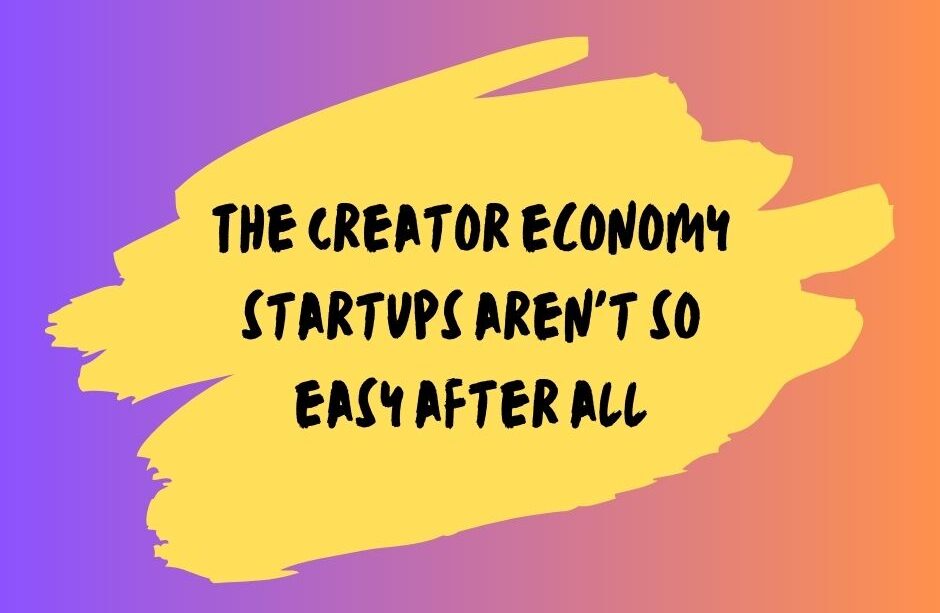
There’s been a big wave of Creator Economy startups over the past few years, as the rise of social media platforms has empowered content creators to become a focal point for consumer engagement. This wave of startups promised creators that they could help them better monetize their audience on social media if they only promoted their products. We’ve all seen these — creators promote a startup’s new offering via a link in bio, or mentions in video or via links — and drive their followers to a landing page that enables some new interaction or functionality involving the creator. Initially, these started almost as “tip jars” but over the years, many, many creative products have been tried, spanning e-commerce to newsletters to Q&A, and more. These products all promised a win/win with creators so that when their fans spent money, the company would only take a % of earnings, usually something like 10% plus or minus.
There have been big successes, with some of these Creator Economy companies hitting billions of earnings paid to creators, while others have struggled. The successful creator startups are much more defensible than previously thought, and new entrants (often with splashy celebrity backing) have struggled to launch. Now that a few years have passed, what have we learned about the dynamics of this sector? Why have some Creator Economy startups worked and why have others lagged?
I have a few theories of the dynamics at play:
- The creator power law: A small, concentrated number of creators have all the audience, which makes Creator Economy startups potentially fragile and dependent
- Battle for the bio link: Creator economy companies acquire their audience from larger social media platforms that often just have one spot — the link in bio — to promote a single company. It’s a zero-sum game to overpower other companies
- The graduation problem: Startups often charge a take rate — % of bookings — and if the creator is acquiring own their customers and also doing the underlying work, they want to pressure you towards reducing costs. The biggest creators often “graduate” from a platform, building their own, and taking their revenue with them
- Algorithmic feast and famine: Creator traffic is driven by social feed algos, which lends itself to big spikes in traffic that appear and then go away — the opposite of the steady, durable growth that startups seek
These are all concepts that I’ve learned from meeting dozens of creator companies over the past few years. And as the next generation of Creator Economy startups emerges, these are some of the dynamics they’ll have to figure out how to navigate. Let’s jump in.
The creator power law
So you want to start a Creator Economy company? The biggest dynamic you have to master is the power law of audience and earnings within the creator class itself.
Here’s a graph that shows % that the top creator earns on a platform like Patron, versus the 2nd and 3rd and 4th creators, all the way down (credit: Power Laws in Culture). You can see there’s quite a dropoff:
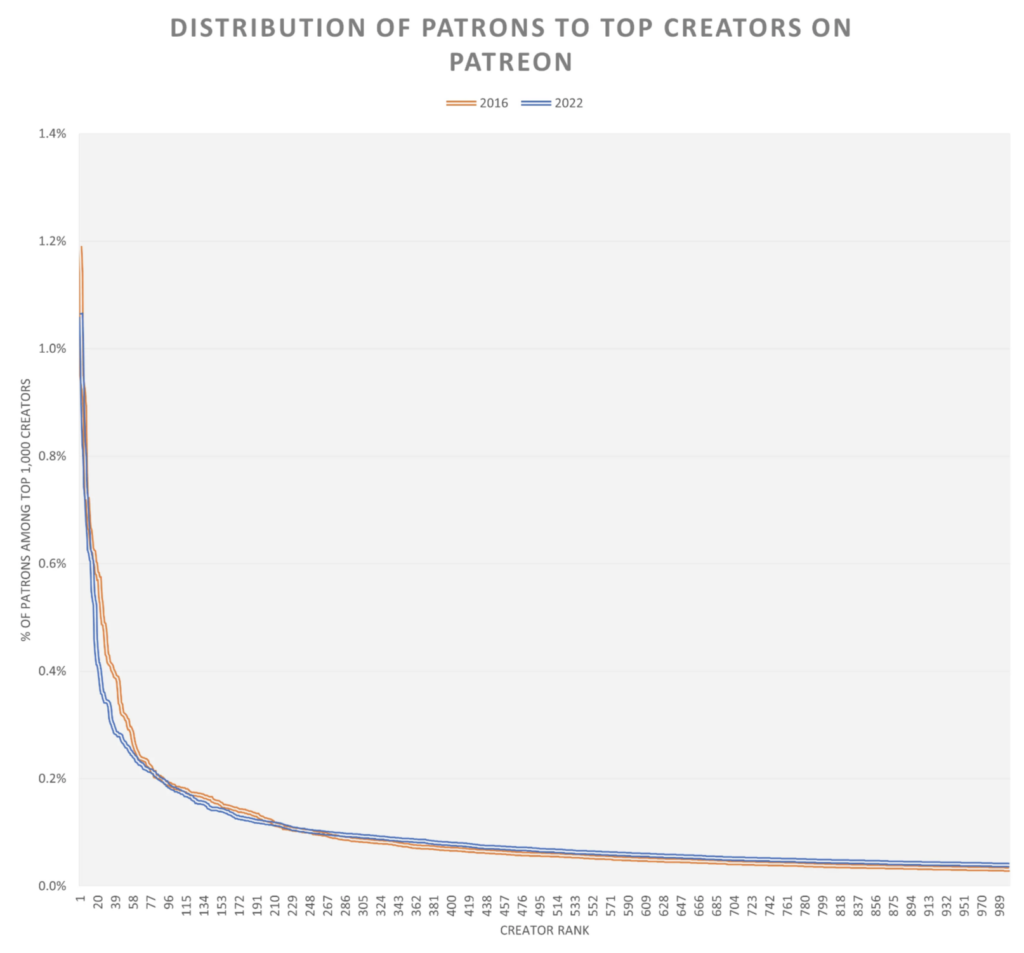
Imagine if you graph this all the way out, to the many millions of creators on these platforms on the x-axis. You’d see that it eventually flattens just one tick above 0%. There’s a lot of reasons why this is the case, starting with the idea that these creator platforms build themselves on top of social media which themselves have well-documented power law distributions for followers and content engagement. In turn, social media platforms have power law curves because of algorithmic discovery, but a small number of social butterflies just know a lot more people than that.
Thus any creator economy product that builds on a social platform inherits these power law curves. OnlyFans creators offer free content on many social platforms that then drive traffic to their private landing pages. Below is a graph of creator earnings, which show a similar curve – via API scraping in the essay The Economics of OnlyFans – showing that while some creators earn up to $100,000/month, the median is closer to $180/month. A familiar curve emerges:
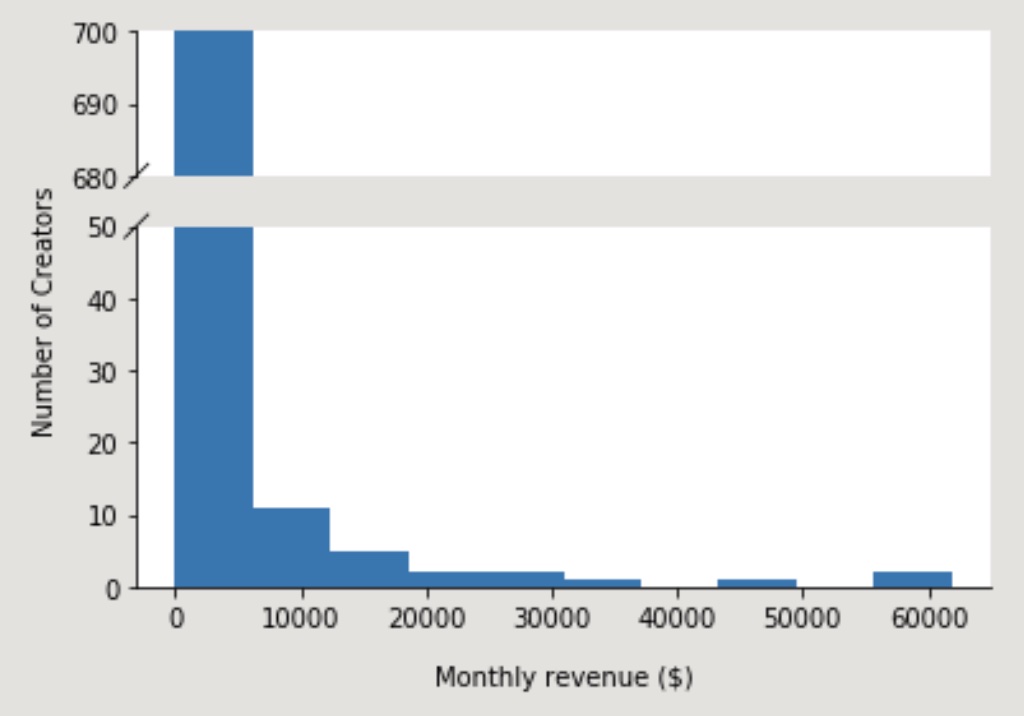
While power laws naturally emerge in social media platforms, that can’t be the only other explanation. The reason is that creative work — including TV, films, music, and more — generally follows a power law pattern. Here’s an example from TV, from the essay Power Laws in Culture (worth reading in its entirety):
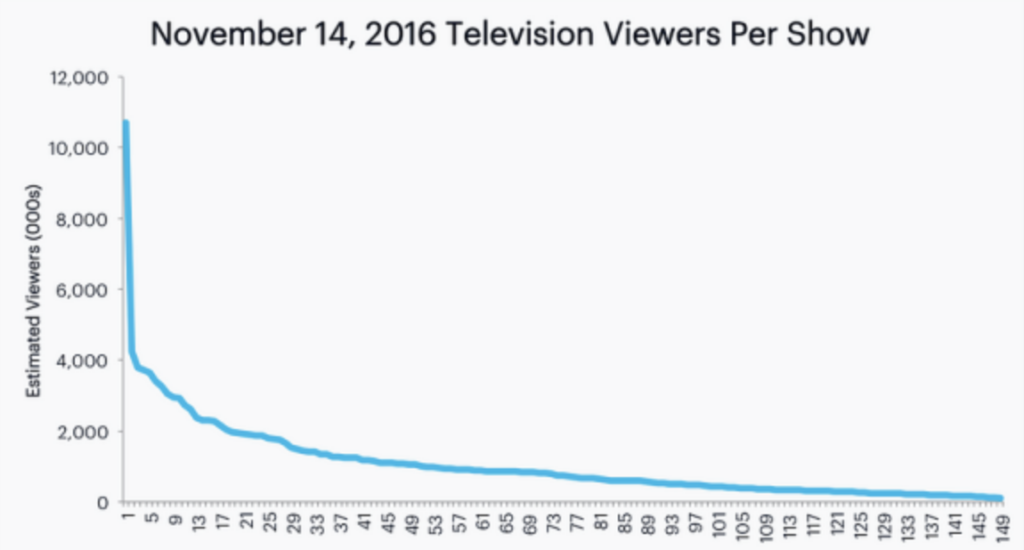
A few hit shows get all the viewers. And if you look at video games, movies, fiction, directors, authors, and more:
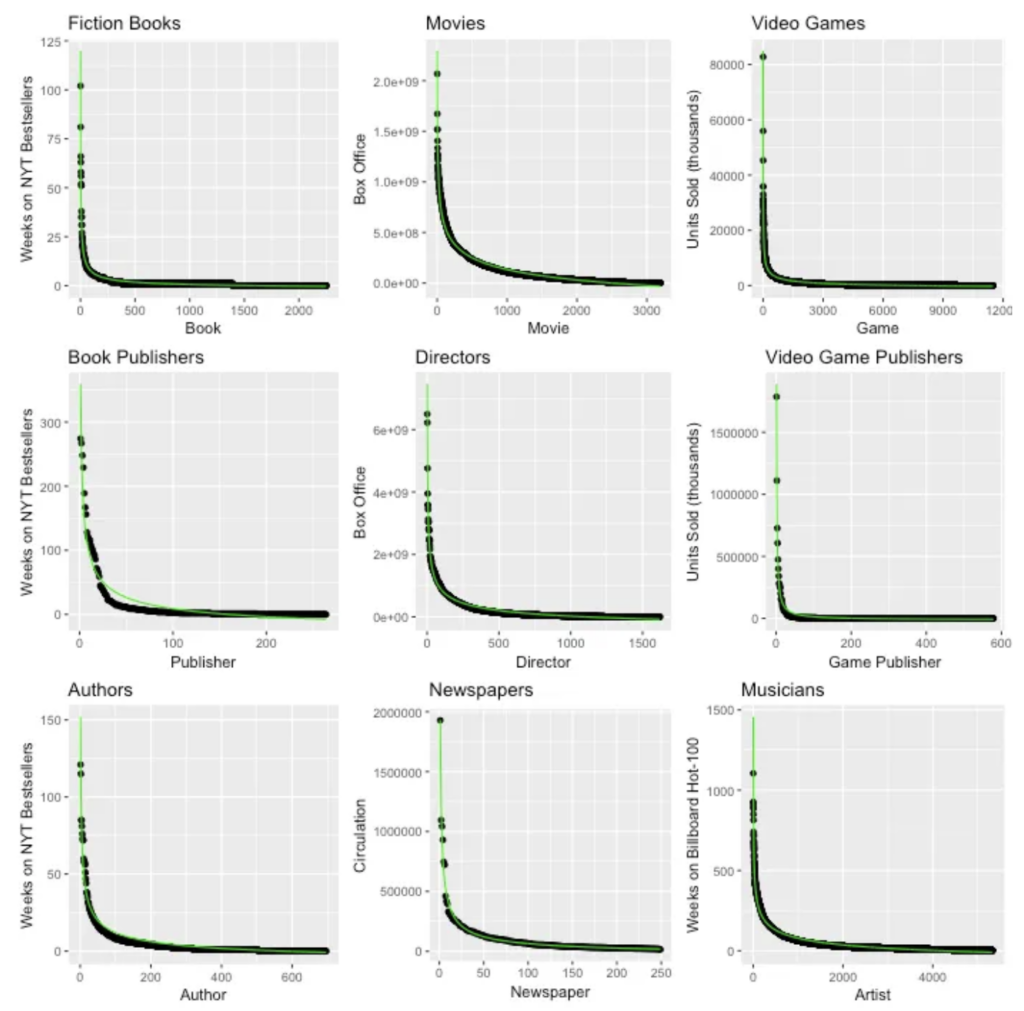
There are a lot of things going on here that might explain the universality of this phenomenon, but one core issue is the uneven distribution of creative skills in the world. A top writer or film director is really just that much better than the 100th. You can look at research output, the distribution of so-called “10x engineers,” and patent filings, for a parallel universe of power laws as well.
So what does this mean for Creator Economy companies? Well, it means a few things:
- When Creator Economy companies first launch, the long-tail creators they initially attract are too small to be meaningful
- To hit scale, they need to attract the largest creators — the ones who are most likely to be distracted with many other projects and products
- And even once you have large creators on your platform, revenue is often quite concentrated into a small group — so that if they churn, the financial impact can be big and negative
These dynamics all mean that the initial phase of a startup’s launch can be perilous. The best companies can aggregate so many small creators that the numbers start to matter, or organically attract large/mid-sized players. If a startup finds itself manually DMing/acquiring/handholding many creators (read: high cost of acquisition and ongoing service), then that’s a sign that the product might not solve a big enough problem for things to happen on their own.
The battle for the bio link
Social media platforms like Instagram and TikTok have advertising business models, and as a result, they don’t want to give people *too much* organic traffic. Better they make you pay to sponsor posts, creators, and ads. One way they’ve done this has been to offer a single link for driving organic traffic — the infamous “link in bio” — that appears at the top of a profile.
This is insanely valuable real estate for Creator Economy startups. If you can convince a creator to place your startup into this link, then organic traffic will appear in your product. With some monetization mechanics in place, the startup takes its cut. And initially, it worked. Early in the Creator Economy cycle, startups were competing with non-monetizing links — either links to other social media profiles or personal websites. But as time went on, people began to fill their bio links with highly monetizing links to Patreon, Substack, Twitch, and otherwise — this is much fiercer competition.
It’s now a zero-sum battle to displace another startup’s link in bio. The only way to gain organic traffic from creator profiles is by monetizing better than other older, more proven competition. If you simply match what an incumbent might make you, then that’s not enough – it has to be significantly more. Or you have to find a different piece of real estate, whether that’s inside the creator content itself – whether that’s video, text, or otherwise. Either way, new entrants will find this a major barrier, and while they might be tempted to subsidize earnings with investor money initially, that may not be enough to reach a meaningful scale.
The graduation problem
The graduation problem is what happens when your best customers get big, and eventually “graduate” — taking themselves and their customers off of your platform. Why does this happen? Creators provide obvious value to startups — driving traffic, creating content, and monetizing their users — and that makes the Creator Economy model attractive. But work with creators long enough, and they often think to start to think it’s *too* attractive. They start to think, they’re doing all this work, what gives you the right to charge XX%? Why isn’t this a $99/month WordPress subscription, why do I have to pay a %? This is particularly problematic because of power law curves, where a small number of whales often dominate top-line revenue. If a whale starts to ask, couldn’t they replicate your product by hiring an agency and paying them to build a custom website, then there’s a huge temptation to drop take rates to accommodate them. They eventually are tempted to “graduate” from the platform, reaching sufficient scale to build their own platform.
Contrast this to marketplaces startups and the on-demand wave to which the Creator Economy is often compared. In that sector, a company like Airbnb or Uber aggregates both the supply and demand sides of the network independently. These 2-sided marketplaces work best when each side is highly fragmented, which is why the biggest outcomes have been consumer-to-consumer or consumer-to-SMB marketplaces, versus B2B. (More on this from an essay of mine from a few years back, What’s Next in Marketplaces). In their initial formation, Creator Economy startups look more like B2B networks or maybe even SaaS platforms — their customer bases (the creators) are highly concentrated, and the creators bring their consumers. No wonder the frustration.
To overcome the graduation problem, Creator Economy startups have to provide a significant amount more value than the utility of payments and other commoditized tech. They need to have a moat, not just for external companies but also for their own customers who are tempted to graduate over time. The best version of this is to create network effects on their own — by acquiring and cross-pollinating customers and bringing them to each creator, a 2-sided network forms, with all of its usual advantages. (I describe all these dynamics more in my recent book, The Cold Start Problem). The additional functionality that the startup creates should ideally be proprietary on its own. If an AI-enabled creator economy company develops a very good foundational model that allows creators to monetize 10x more than before, it’s unlikely the creator will ever leave.
Algorithmic feast and famine
Creator economy startups often find themselves highly dependent on the whims of social media platforms and on the hits-driven nature of viral content. If a video goes viral on TikTok, a big spike in user acquisition might ensue. But startups are always trying to grow steadily month by month, and unlike SEO or referral programs, or paid marketing, it’s hard to create a consistent march of 20% MoM growth. Compare this to marketplace startups, which add value by doing the work to aggregate each side of the market — often spending billions of dollars to build buyers and sellers. When I was at Uber, during the hypergrowth years, the annual performance marketing budget to acquire Uber riders was a billion, and the driver side was close to $2B, and that was diversified across SEO, brand marketing, paid, referral programs, partnerships, and otherwise. This added a ton of value since the two sides couldn’t connect otherwise.
Creator economy startups are different in that they use creators to find their customers, but in doing so, they are highly dependent on a single channel. A dependency on a single marketing channel is always dangerous, as we’ve seen in prior years where changes to SEO algorithms obliterated multiple generations of SEO-dependent content sites. A dependency on social media is even more fragile since the content is naturally more ephemeral and delicate. I think this is also one of the reasons why subscription (with upgrades) has become the dominant business model for successful Creator Economy companies — allowing creators to build a long-term, durable revenue stream from each follower is just much more stable than a transactional model. It’s just much easier to stack revenue over time this way.
Algorithmic feeds also play into a competitive factor. In recent years, we’ve also seen YouTube, Twitch, Twitter, and other underlying platforms try to go after directly paying creators themselves and playing a more vertically integrated role in the Creator Economy. As this happens, you could imagine a multitude of platform shenanigans where they try to hoard creator relationships at the expense of new startups.
The best solution here, of course, is to layer on additional marketing channels to drive predictability. Combine a spiky social media channel with steady retention, an inflow of traffic from referral, SEO, mobile installs, and otherwise, and the growth curve becomes much more durable. But in the early days of a Creator Economy startup, they’re often going all-in on social, and it’s only with success that they can choose to invest in the other channels.
The upside and the future
Creator Economy companies are going through their second and third generations of startups. The bar has gotten higher. Instead of providing functionality akin to fancy tip jars, startups are building full-blown products — supporting multiple platforms, new forms of interaction, and providing new functionality for creators to interact with their followers. These products will have network effects of their own, sometimes becoming destinations of their own. And instead of launching a product anchored by one celebrity and expecting it to succeed, instead, startups are building real technology — often involving AI — combined with a broad go-to-market strategy.
The upside of this sector is that mobile use, and thus social media platforms, continue to grow incredibly fast, taking time away from the hours that people used to spend watching TV:
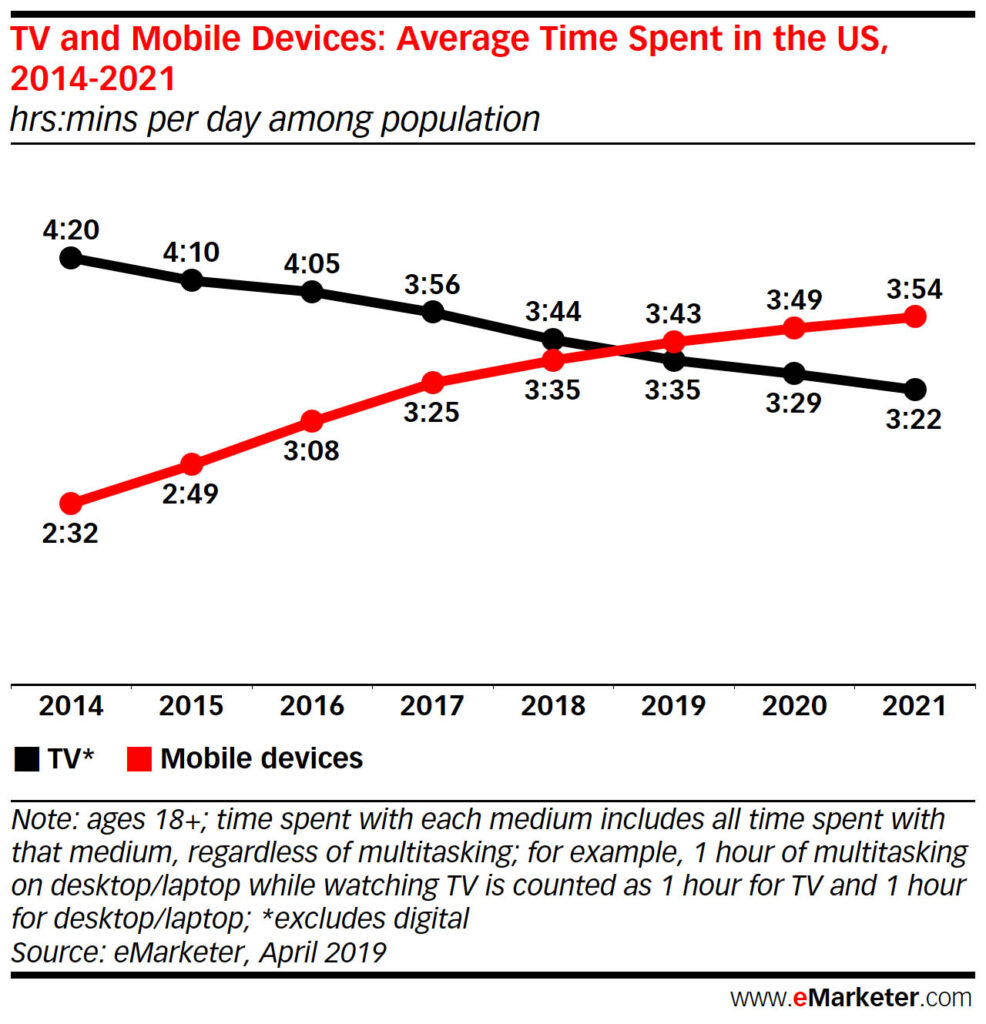
A lot of this movement is of course driven by younger generations:
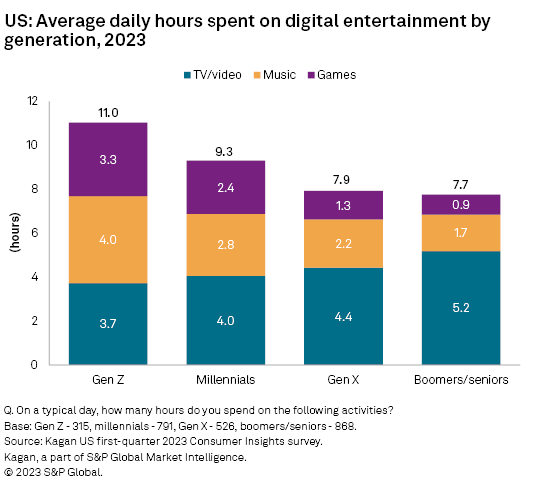
(btw, can you believe that most 18+ people still watch 4-5 hours of TV a day?)
The point is, social media continues to play a huge role, and creators are ultimately a new class of participants in the economy that continue to gain power in both cultural and economy terms. And the products and tooling they use to fulfill their goals will continue being attractive. This is especially true because in the end, creators don’t want to be dependent on one social platform themselves — if they are strong in video, they want to go to podcasting, and to have a huge Instagram. And startups can always seek to be friendlier to the creators than the mega-social platforms.
Thus, I argue that the future of the Creator Economy continues to be promising, but the approach has significantly evolved and the bar has been raised. Startups will need to provide new functionality, create new forms of monetization, and adopt new technologies that make them more defensible to competition and in-house efforts by creators to replace them. Personally, I’m much more interested in Creator Economy startups that are AI- or video-first, and act more like marketplaces in providing a highly managed solution to both sides. I’m more bullish about startups that know how to collect $1000 from a smaller niche of users — thus creating more value — rather than a tip jar model that collects $2 from everyone. In coming years we will see many more variations that will work, and given the underlying consumer trends, I’m bullish this will remain a source of highly valuable startups.
PS. Get new updates/analysis on tech and startups
I write a high-quality, weekly newsletter covering what’s happening in Silicon Valley, focused on startups, marketing, and mobile.
Views expressed in “content” (including posts, podcasts, videos) linked on this website or posted in social media and other platforms (collectively, “content distribution outlets”) are my own and are not the views of AH Capital Management, L.L.C. (“a16z”) or its respective affiliates. AH Capital Management is an investment adviser registered with the Securities and Exchange Commission. Registration as an investment adviser does not imply any special skill or training. The posts are not directed to any investors or potential investors, and do not constitute an offer to sell — or a solicitation of an offer to buy — any securities, and may not be used or relied upon in evaluating the merits of any investment.
The content should not be construed as or relied upon in any manner as investment, legal, tax, or other advice. You should consult your own advisers as to legal, business, tax, and other related matters concerning any investment. Any projections, estimates, forecasts, targets, prospects and/or opinions expressed in these materials are subject to change without notice and may differ or be contrary to opinions expressed by others. Any charts provided here are for informational purposes only, and should not be relied upon when making any investment decision. Certain information contained in here has been obtained from third-party sources. While taken from sources believed to be reliable, I have not independently verified such information and makes no representations about the enduring accuracy of the information or its appropriateness for a given situation. The content speaks only as of the date indicated.
Under no circumstances should any posts or other information provided on this website — or on associated content distribution outlets — be construed as an offer soliciting the purchase or sale of any security or interest in any pooled investment vehicle sponsored, discussed, or mentioned by a16z personnel. Nor should it be construed as an offer to provide investment advisory services; an offer to invest in an a16z-managed pooled investment vehicle will be made separately and only by means of the confidential offering documents of the specific pooled investment vehicles — which should be read in their entirety, and only to those who, among other requirements, meet certain qualifications under federal securities laws. Such investors, defined as accredited investors and qualified purchasers, are generally deemed capable of evaluating the merits and risks of prospective investments and financial matters. There can be no assurances that a16z’s investment objectives will be achieved or investment strategies will be successful. Any investment in a vehicle managed by a16z involves a high degree of risk including the risk that the entire amount invested is lost. Any investments or portfolio companies mentioned, referred to, or described are not representative of all investments in vehicles managed by a16z and there can be no assurance that the investments will be profitable or that other investments made in the future will have similar characteristics or results. A list of investments made by funds managed by a16z is available at https://a16z.com/investments/.
Excluded from this list are investments for which the issuer has not provided permission for a16z to disclose publicly as well as unannounced investments in publicly traded digital assets. Past results of Andreessen Horowitz’s investments, pooled investment vehicles, or investment strategies are not necessarily indicative of future results. Please see https://a16z.com/disclosures for additional important information.